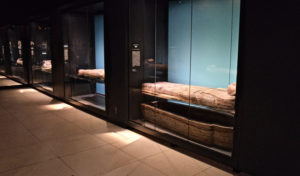
Only a pair of mummified knees and sandals remained.
When in 1904 Italian archaeologist Ernesto Schiaparelli discovered and excavated the great tomb of Nefertari, Queen and wife to Ramesses the Great, the third pharaoh of ancient Egypt’s 19th Dynasty, there was virtually nothing to be found of the queen’s mummy. Among the scattered effects on the tomb floor, however, remained several items that could possibly be directly connected to her physical body — two mummified knees, a pair of remarkably well preserved sandals, parts of gold bracelets, and a small piece of an earring or pendant. Archaeologists also found small shabti figurines, large fragments of the queen’s pink granite sarcophagus lid, and fragments of a gilded wood coffin. Like so many other tombs, this burial chamber had been robbed in antiquity of most of its precious goods.
Despite this, a remarkable archaeological legacy remains. The ancient robbers didn’t take most of the wall paintings. Energy, time, and lack of portability got in the way. And this was fortunate for posterity, because to this day they still represent the most detailed and best preserved ancient Egyptian depiction of the journey toward the afterlife. Nicknamed the “Sistine Chapel of ancient Egypt”, the tomb also represents one of ancient Egypt’s best artistic documentations of its elite culture and the life and ways of one of its great queens. And personal: In poetic fashion, splashed across the walls of her tomb, Ramesses even declared the depth of his love for his wife:
My love is unique — no one can rival her, for she is the most beautiful woman alive. Just by passing, she has stolen away my heart.
Recently, select artifacts covering 520 square meters of floor space and 5,200 square feet of wall paintings could be seen at a National Geographic special exhibit entitled Queens of Egypt in Washington, D.C. The exhibit featured, among many other objects, a detailed scale model of the massive underground two-tiered tomb and a 3D visualization of the tomb wherein visitors can walk, much like a virtual reality experience. Beyond a visual telling and display dedicated to Nefertari, artifacts related to at least four other major Egyptian queens, including an exhibition of objects recovered from excavations of the worker settlement at Deir El-Medina (near to which the tomb of Nefertari is also located), and an array of other ancient coffins, were presented. The showing exemplified the prominent place Egyptian queens played in the ancient Egyptian culture and power structure.
More Than A Queen
Though Nefertari was one among a group of wives constituting Ramesses’ harem, she was, no doubt, first and supreme. She wielded enough influence to serve as a trusted advisor, and this extended to matters of diplomacy. As his Great Royal Wife, she corresponded with foreign leaders of the time and accompanied him on his military campaigns. Highly educated, she could read and write in hieroglyphics, a rare knowledge and skill for women, and certainly uncommon among most of the population. Revered and honored among her peers and the Egyptian population, she is known by many titles, including Great of Praises (wrt-hzwt), Sweet of Love (bnrt-mrwt), Lady of Grace (nbt-im3t), Great King’s Wife (hmt-niswt-wrt), His Beloved (hmt-niswt-wrt meryt.f), Lady of The Two Lands (nbt-t3wy), Lady of all Lands (hnwt-t3w-nbw), Wife of the Strong Bull (hmt-k3-nxt), god’s Wife (hmt-ntr), Mistress of Upper and Lower Egypt (hnwt-Shm’w-mhw), and ‘the one for whom the sun shines’. Nefertari’s prominence at court is also attested through cuneiform tablets from the Hittite city of Hattusas (today Boghazkoy, Turkey), containing Nefertari’s correspondence with the king Hattusili III and his wife Puduhepa.
Nefertari married Ramesses before he had ascended to the throne, and together they had at least seven children, with at least four sons and two daughters constituting the royal family.
Great honor was bestowed on Nefertari at Abu Simbel, in Nubia. She is represented in several colossal standing statues at the great temple, and a small temple is dedicated to Nefertari and the goddess Hathor.
_____________________________
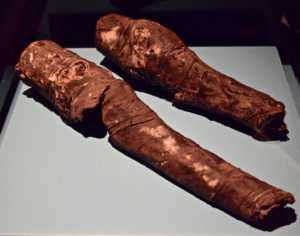
A report by science journal PLOS ONE published November 30, 2016, has indicated that a pair of mummified legs found in QV66 and now at the Museo Egizio of Turin (pictured above as exhibited on loan to the National Geographic Society’s exhibit, The Queens of Egypt) may indeed be Nefertari’s based on the bone structure and the age of the person, which fits the profile of Nefertari. Habicht, Michael E.; Bianucci, Raffaella; Buckley, Stephen A.; Fletcher, Joann; Bouwman, Abigail S.; Öhrström, Lena M.; Seiler, Roger; Galassi, Francesco M.; Hajdas, Irka; Vassilika, Eleni; Böni, Thomas; Henneberg, Maciej; Rühli, Frank J. (November 30, 2016). “Queen Nefertari, the Royal Spouse of Pharaoh Ramses II: A Multidisciplinary Investigation of the Mummified Remains Found in Her Tomb (QV66)“. PLOS ONE. PLOS ONE. 11 (11): e0166571. doi:10.1371/journal.pone.0166571. PMC 5130223. PMID 27902731
_____________________________
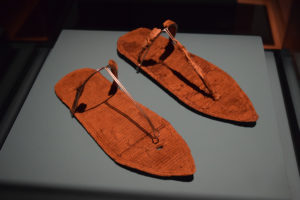
Pair of well-preserved sandals found in Nefertari’s tomb. As displayed at the exhibit, Queens of Egypt.
_____________________________
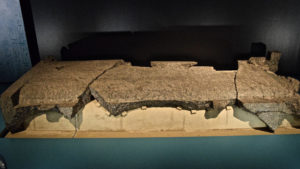
The remaining fragments of Queen Nefertari’s granite sarcophagus that were found within the tomb, on display on loan in the exhibit, Queens of Egypt.
_____________________________
Who really built the tomb of Nefertari?
Popular literature and history have traditionally told us that the great tombs of Egyptian pharaohs, queens and the royal elite were ordered/commissioned by royal leadership and built under their direction. But we know the actual day-to-day labor for construction and skilled craftsmanship required to complete them was exercised by hundreds of workers. Such was also the case for Nefertari’s tomb. Archaeology has been prolific over centuries at revealing the artifacts, remains and monuments of the royal elite, but much less productive at uncovering the evidence for the thousands of workers who built and lived in ancient Egypt. This is in part because their remains, including their domestic structures, for a variety of reasons were much more vulnerable to the weathering vicissitudes of time. Some evidence has emerged, however, that has shed light on the workers and everyday lives of the non-elite population. No better example of this has been provided than by the discovery and excavation of the ancient workers’ village of Deir el-Medina, established to house and support the many workers, artisans and craftsmen who built and decorated the tombs in the Valley of the Kings and the Valley of the Queens.
Known anciently as Set maat , “The Place of Truth”, it was excavated by Bernard Bruyère beginning in the early 1920’s, and the research has resulted in a detailed look at an ancient Egyptian community that thrived almost four hundred years, from the reign of Thutmose I (c. 1506–1493 BCE) until sometime during the reign of Ramesses XI (c. 1110–1080 BCE). Located on the west bank of the Nile, across the river from modern-day Luxor, the village was situated close to the Valley of the Kings (to its north) and the Valley of the Queens (to its west). In its heyday it had about sixty-eight houses with a road running through the village. The structures averaged about 70 m2 each in area, built of mudbrick atop stone foundations. Analysis of the excavated materials indicate that mud was applied to the walls and then painted white. Using wooden doors in front for entrance, the houses consisted of four to five rooms, featuring the entrance, a main room, two smaller rooms, a kitchen and a cellar, as well as a staircase to the roof. The main room featured a platform with steps—interpreted by archaeologists to have been part of a shrine or birthing bed. Also indicative of their religious culture, the houses appear to have contained niches for statues and small altars, and the village had its own tombs that featured rock-cut chapels and substructures with small pyramids. Many other small artifacts have been recovered, including tools and items for personal use, providing a more intimate insight into the daily lives and needs of the village worker population.
Like they have for their pharaohs, the remains of Deir el-Medina have served as an enduring testament to the reverence and regard the ancient Egyptians held for their queens.
____________________________

Stela of Penbuy. From Deir el-Medina, New Kingdom, 19th Dynasty (c. 1292 – 1189 BC). A craftsman named Penbuy, his wife and son raise hands to a deified Queen Ahmose-Nefertari. Previously on display at the Queens of Egypt.
____________________________

A scribe’s wooden palette. Found at Deir el-Medina. As shown in Queens of Egypt exhibit.
____________________________
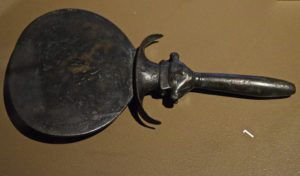
Mirror with hathoric handle. Personal items like mirrors were among objects unearthed at Deir el-Medina. As shown in Queens of Egypt exhibit
____________________________




